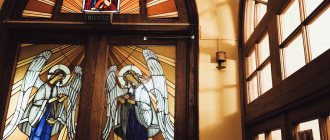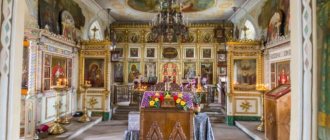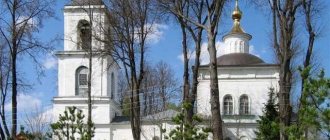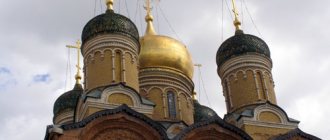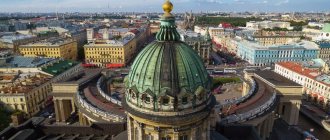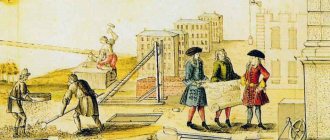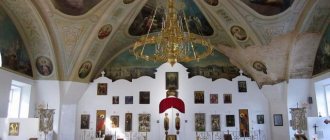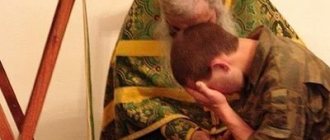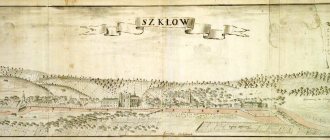"Save me, God!".
Thank you for visiting our website, before you start studying the information, please subscribe to our Orthodox community on Instagram, Lord, Save and Preserve † - https://www.instagram.com/spasi.gospodi/. The community has more than 60,000 subscribers. There are many of us like-minded people and we are growing quickly, we post prayers, sayings of saints, prayer requests, and timely post useful information about holidays and Orthodox events... Subscribe. Guardian Angel to you!
In the Northern capital there is a fairly large number of temples and cathedrals that are revered by Orthodox parishioners. But the Cathedral of the Vladimir Icon deserves special attention. It is considered the oldest and has an interesting history.
History of the Cathedral
The history of the majestic temple began in the 18th century with a small temporary church located in a private house, which was visited by townspeople living in the area. There was not enough space for parishioners, and then in 1745 a small wooden church , the basis for which was the old chapel.
This church quickly fell into disrepair, and city residents turned to the empress with a request to build a new building
In 1760, the stone foundation was laid for a grandiose construction project. The fundraiser was organized by John Kirikov , who did not live to see the consecration of the temple for 13 years; he died at the hands of robbers. The exact opening date is unknown; the temple was consecrated in 1783 .
The reconstruction of the church was accompanied by the redevelopment of the surrounding territory, so of the same name appeared - Vladimirskaya.
History of the image
The temple is named after the Miracle-Working Icon of the Mother of God ; according to legend, it was painted by Luke on the tabletop, at which the Savior and the Mother of God had previously eaten.
Seeing the image created by the Holy Apostle, the Most Pure Virgin said: “The grace of the One born of Me and Mine be with this image.”
In the 12th century, was made and presented to the Principality of Kiev to Yuri Dolgoruky , the original was in Constantinople.
The Holy Image was placed in the Kiev monastery, but a few years later one of Dolgoruky’s sons , Andrei, decided to transport the icon to the north of the state. During the move, after a rest in the city of Vladimir , the horses carrying the platform on which the icon was located stopped and did not want to move further.
The prince turned to the Savior in prayer for help. In a vision, the Mother of God appeared to him and commanded him to leave the icon in this city, since then it has been named Vladimir.
Moving icons:
- in 1480, the Face of the Savior was transported to the Moscow Patriarchate and placed in the Assumption Cathedral ; a copy created by Andrei Rublev remains in Vladimir
- after the revolution, the image was placed in the Tretyakov Gallery , where it remained until the end of the twentieth century
- in 1999 she was transported to Tolmachi, to the Church of St. Nicholas
Since the appearance of the Miraculous Image, many amazing events associated with it have been recorded.
- At the end of the 14th century, a religious procession was held with the Great Image in hand. People asked the Mother of God to protect them from Khan Tamerlane , who attacked Russia. The Savior appeared to Tamerlane in a dream and ordered him to stop the war . Khan obeyed and retreated.
- A procession along the city walls with the Miraculous Icon in their hands saved the capital from an attack by the Tatars in the middle of the 15th century. After a crowded prayer of the townspeople to the Mother of God, for unknown reasons, the Tatars stopped the siege of the city.
- The battle with the Tatar-Mongols never took place at the end of the 15th century. Russian soldiers came out to meet the enemy, carrying the icon of the Savior in the front row. The enemy immediately retreated .
Many miracles and healings are associated with the Miraculous Icon. Prayers to her are always heard; they have more than once saved the country and everyone who turned to her with faith and hope during difficult trials. As a sign of gratitude, people brought pearls, gold and silver rings, which they used to decorate the Image of the Savior.
In the Cathedral there is a copy of the Miraculous Icon, revered no less than the original, which is placed in a case with bulletproof protection and is located in the Tretyakov Gallery Museum.
Temple status
The cathedral , in which the Miraculous Image is located, is considered the most important and significant in its region. cathedral status in 2000. It is given forever and is not subject to revision, therefore the cathedral occupies a special position - it is distinguished from a simple temple by the fact that Divine Services are conducted only by the Highest Spiritual Priests :
- bishop
- archbishop
- patriarch
- metropolitan
The category of Cathedral is assigned for some special reason; Divine Liturgies are conducted in them by the bishop. In such a Cathedral, the presence of a pulpit is required - a special episcopal throne, which is installed on the eastern side of the altar.
Warm pier
I really love this cozy and at the same time grandiose cathedral of St. Petersburg. When you enter it, your soul immediately becomes lighter, even on cloudy days. It was here that the amazing Theodore Icon of the Mother of God was brought from the Kostroma Monastery not so long ago.
It is believed that this Image belongs, like the image of the Vladimir Mother of God, to the Evangelist Luke. The “Feodorovskaya” icon is named in honor of the father of the holy prince Alexander Nevsky - Grand Duke Yaroslav Vsevolodovich, who was named Theodore in baptism (in honor of St. Theodore Stratilates). Yaroslav-Theodore blessed his son with this icon during his marriage. This miraculous Image is interesting because it is two-sided. On its back is the image of the Holy Great Martyr Paraskeva, dressed in an expensive princely robe (her appearance is associated with the wife of Alexander Nevsky).
I met this amazing icon again, completely unexpectedly for myself, when, finding myself in the city center, I accidentally walked into the Vladimir Church. Before that, I saw her in Moscow during an Orthodox exhibition and in Kostroma itself during the celebration of the Transfiguration of the Lord. Indeed, the Orthodox saying is true that “chance is a pseudonym for God, who simply did not leave his autograph”...
And perhaps it was no coincidence that you also read my article about the wonderful Vladimir Cathedral...
Architecture
From the middle of the 18th century, by decree of Empress Elizabeth Petrovna , traditional Christian five-domed churches began to be built in the capital , which replaced churches with an architecture reminiscent of Lutheran ones.
The name of the author of the Vladimir architectural complex is still unknown. There is a version that it could be the Swiss architect Antonio Trezzini.
The names of other craftsmen who worked on the construction of the temple are known:
- S. Chevakensky
- A. Rinaldi
- I. Starov
- A. Kvasov
The two-story building was built in a classical, strict and restrained style , but the facades and bell towers are decorated with lush Baroque elements :
- stucco decoration
- Corinthian columns
- beam arches
- many sculptures located on the facades
Domes and figured towers of various sizes , again in the Baroque style, decorate the stone chapels and side additional altars.
The cathedral has several altars.
On the lower warm floor they are consecrated in honor of the saints:
- central – John of Damascus
- northern – Hieromartyr Harlampius
- southern - the prophet Elijah
On the upper cold floor the altars are dedicated to the Holy Faces:
- main – Our Lady of Vladimir
- right – Joy to All Who Sorrow
- left - Sofia and her daughters Vera, Nadezhda, Lyubov
The main mass of the five-domed structure surprisingly seamlessly merges with the bell tower, which is 67 meters high.
dasha_mevsha
starodubtsev812
bellalinalove
bored314
A three-tier bell tower was erected next to the temple at the end of the 18th century according to the design of Kvarnegi , and in the 50s of the 20th century an additional tier was added to it according to the design of the architect Ruska, who later supervised the construction of the fence around the cathedral and two chapels.
In those days, there was a wonderful garden behind the fence, of which only minor remains remain today.
Since the 19th century, the domes of the temple were covered with gilding, but after the revolution it was washed off and the domes were painted black. Currently, the Cathedral is in the stage of revival, restoration work is underway , and gilding is being applied to the domes and bell towers again.
The vestibule of the church, facing the western side , is made in the classical style according to Melnikov's design. Previously there was an orphanage and an almshouse there.
Pietro Trezzini
In 1745, a wooden church was erected on the site of the modern Vladimir Cathedral in St. Petersburg. Construction of the stone structure began 15 years later. The author of the project of the Vladimir Cathedral in St. Petersburg is the Swiss architect Pietro Trezzini. This man was educated in Italy and worked in Milan for several years. In 1726 Trezzini arrived in St. Petersburg, and 17 years later he took the position of chief architect of the city. In addition to the Vladimir Cathedral, the Spaso-Sennovskaya and Panteleimonovskaya churches were erected in St. Petersburg based on his designs.
What does the Cathedral look like inside?
A distinctive feature of the decoration is sophistication and simplicity. On the walls , decorated with pilasters, the four Evangelists are depicted by Bryullov’s hand. On the western side of the temple there are amazing copies of paintings by Raphael and Paolo Veronese. In the upper building, an iconostasis has been preserved, in which there are about 30 sacred icons. Rastrelli created a unique creation in the 18th century, placing the Holy Faces on both sides of the altar.
mane_tanya
ludmilabtt
anastasiia_0012
The main revered miraculous icons of the temple:
- Vladimir Mother of God
- Savior Not Made by Hands - she was consecrated by the righteous John of Kronstadt;
- The face of the Great Elder Seraphim of Sarov with incorruptible parts of his relics.
To the right of the list of the Kazan Icon there is a wooden iconostasis made in the Empire style , decorated with artistic carvings . The altar is painted with a copy of the composition Holy Eucharist by Vasnetsov.
Ioann Kirikov
This man was not only the first rector of the temple, but also its main builder. At the end of the nineties of the last century, the grave of John Kirikov was discovered near the altar and then reconstructed. The inscription, embossed back in 1870, was also restored.
The architectural ensemble of the church, which modern parishioners see, took shape in the mid-19th century. There is absolute harmony of proportion here, as you can see by visiting St. Vladimir Cathedral in St. Petersburg.
Divine services
You can attend the Divine Liturgy every day
During weekdays:
- Confession – 8:30
- Liturgy – 9:00
Sunday and holidays:
- Confession – 6:30, 9:30
- Liturgy – 7:00, 10:00
The temple is open from 8:00, evening prayers - at 18:00
Entrance to the temple is free . more about the history of Vladimir Cathedral by visiting it as part of excursions , the cost of which is 500-1000 rubles per person, depending on the duration of the event.
Interior decoration
Sculptures of the four Evangelists have been preserved on the vaults of the main dome. On the second floor you can see a carved iconostasis of rare beauty, which came to the temple in 1808.
This work of art was created by Russian craftsmen based on a drawing by the famous architect Francesco Bartolomeo Rastrelli for the Anichkov Palace. It is noteworthy that no more than a dozen such monuments of Peter the Great’s Baroque remain in our country.
View of the Vladimir Icon of the Mother of God above the entrance to the cathedral
Interesting Facts
- The cathedral is famous for its children's choir , whose singers are known far beyond Russia for their angelic voices.
- A school of virtuoso bell ringers has been opened at the cathedral ; they are taught complex bell ringing techniques.
- The history of the temple is connected with many famous parishioners. A. S. Pushkin’s parents lived near the square where the temple is located and often attended divine services. Alexander Sergeevich himself often visited his relatives and went to the Vladimir Church for Liturgy.
- The funeral service for Pushkin's nanny and his friend Delvig took place in the Vladimir Cathedral , which was attended by the poet.
- To this day, memorial services are held in the church for F. M. Dostoevsky , who lived in Kuznechny Lane and was a diligent parishioner of the Vladimir Church.
Architectural features
The ancient St. Petersburg Cathedral represents the transition from the traditions of the magnificent Catherine Baroque to laconic and strict classicism. In plan it looks like a square with cut corners. Graceful domes rest on tall cylindrical drums. The facades are richly decorated with pilasters, stucco platbands, arched arches and slender columns of the Corinthian order.
View of the domes of Vladimir Cathedral
To the north of the cathedral stands a magnificent four-tiered bell tower. It is 68 m high and ends with a round dome and a lantern. The bell tower building looks great from the Trinity Bridge.
Nearby, at the intersection of Dostoevsky Street and Kuznechny Lane, there is an apartment museum and a monument to the writer. In honor of the famous parishioner, memorial services are held annually in the temple.
Clergy
Rectors of the cathedral throughout history Dates Rector 1746-... priest Grigory Matveev 1763 - October 20 (November 1) 1770 priest John Kirikov (...-1770) 1770-1783 priest Jacob Ivanovich Graevsky 1783-1789 archpriest Iakov Illarionov (...-1789) 1789- 1798 priest Philip Vasiliev 1790-1808 priest Ioann Fedorovich Bashilov 1808-1810 archpriest Ioann Nikitich Golubev 1810-1825 archpriest Pavel Petrovich Sviyazev (...-1825) 1826-1831 archpriest Simeon Yakovlevich Platonov (...-1831) 1831 - January 22 (February 3) ) 1864 Archpriest Mikhail Nikitich Malein (1788-1864) 1864-1892 Archpriest Alexander Nikolaevich Sokolov (1817-1903) 1892-1893 Archpriest Dimitry Alexandrovich Priselkov (...-1909) 1893-1895 ... 1895-1902 Archpriest Nikolai Mikhailo Vich Viroslavsky 1902-1903 Archpriest Dimitry Alexandrovich Priselkov (...-1909) 1904-1917 Archpriest Alexander Alekseevich Vladimirsky 1917 - June 1922 Archpriest Pavel Antonievich Kedrinsky (1863 - after 1935) October 1922 - August 1923 Archpriest Ioann Yakovlevich Sokolov (... - after 1937) August 1923 - June 1 932 Archpriest Pavel Antonievich Kedrinsky (1863 - after 1935) 1932-1990 the temple was not active 1990 Metropolitan Alexy (Ridiger) 1990-1995 Metropolitan John (Snychev) 1996 - present Metropolitan Vladimir (Kotlyarov)
Shrines
The main value of the temple is the iconostasis of the upper altar. It is one of the ten unique creations of church art. The iconostasis project was developed by Rastrelli himself. It was brought to life by the best masters of the Elizabethan era.
But the most important thing that the Vladimir Church (St. Petersburg) is really proud of is its icons. In first place is the image of the Mother of God itself, which came to Russia at the beginning of the twelfth century from Byzantium. Its author is the evangelist Luke, who depicted Mary with her husband and little Christ eating a meal.
If you look at the icon from the reverse side, you can see the image of the throne and the instrument of passion.
Another shrine of the cathedral is “Savior Not Made by Hands”. This icon depicting the Savior is famous for the fact that, according to legend, it gives strength to overcome difficulties, helps overcome illnesses and gives tips in solving problems. It is this miraculous image that the Vladimir Church (St. Petersburg) is famous for.
Sunday schools
Today, a children's Sunday school operates at the Vladimir Cathedral. It's called "Logos". One of the main goals of Sunday school is to revive lost family traditions and introduce children to Orthodox culture. Classes at this center are held only on Saturdays and Sundays. Education at school is mainly structured in the form of dialogue, which takes place during a conversation with a church minister. Here any boy can feel like an altar boy. Girls attending Sunday school, in addition to such indispensable subjects as temple studies and the study of the New Testament, study in a handicrafts group. There is also a theater studio at the temple, and drawing classes are held. Vladimir Cathedral publishes its own newspaper.
